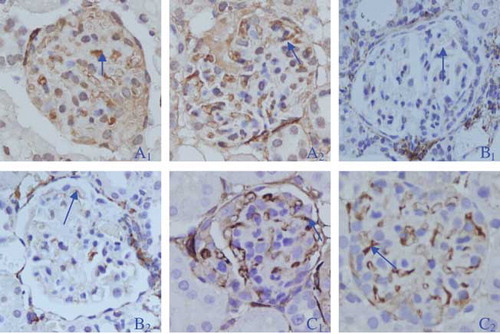Sirs,
Peroxisome proliferator-activated receptor gamma (PPARγ) agonists have beneficial effects on renal damage associated with different pathologies. The model of glomeruli lesion induced by puromycin aminonucleoside (PAN) is a classical model of acute nephrotic syndrome. Zuo et al.Citation1 performed an interesting investigation on the association of PPARγ agonist (pioglitazone) treatment with minimal-change disease (MCD) or early-stage focal segmental glomerulosclerosis in rats induced by a single dose of PAN. They observed that the PPARγ expression in MCD model group was weakened and found that PPARγ agonists decreased proteinuria in acute nephrotic syndrome rats. They drew a conclusion that PPARγ agonist treatment was a therapeutic strategy for glomeruli lesion.
We also performed an investigation on the association of the PPARγ agonist (rosiglitazone) treatment with glomerulosclerosis (GS) progression. The glomerulosclerosis lesion was induced by Adriamycin, which was described in our previous study.Citation2 The rats were divided into three groups: sham operation group (SHO), glomerulosclerosis model group without treatment (GS), and glomerulosclerosis model group treated with rosiglitazone (GR). Rats from the three groups were sacrificed 9 and 13 weeks after surgery, and the relevant samples were collected and determined. In our study, we found that mRNA expression of PPARγ in renal tissue and protein expression of PPARγ in glomeruli of the GS group were more weakened when compared with those in the SHO group (p < 0.01 for both), and the mRNA expression of PPARγ in renal tissue and protein expression of PPARγ in glomeruli of the GR group were increased when compared with those in the GS group (p < 0.05 for both; immunohistochemical staining for PPARγ is presented in ). Furthermore, values of 24-hour urine total protein, 24-hour urine excretion for albumin, and protein expressions of transforming growth factor-βl (TGF-βl), α-smooth muscle actin (α-SMA), collagen-IV (Col-IV), and fibronectin (FN) in glomerulus and mRNA expression of TGF-β1 in renal tissue were significantly downregulated in the GR group when compared with those in the GS group (all ps < 0.01), and all these indicators were increased in the GS group when compared with the same in the SHO group (all ps < 0.01). The Pearson’s correlation coefficient was used and significantly negative correlation between protein expression of PPARγ and TGF-β1, α-SMA, Col-IV, and FN in glomeruli was observed (all ps < 0.01). In conclusion, PPARγ agonist could play a protective role against renal damage and could reduce the accumulation of extracellular matrix (Col-IV and FN) in glomerulus of rats in the GS group. The model of glomeruli lesion from Zuo et al.Citation1 and the model from our study were two classical models for glomeruli lesion, and both had a similar manifestation. Our results were similar with those from Zuo et al.Citation1, which indicated that the conclusion from Zuo et al.Citation1 was robust to some extent.
Figure 1. Representative samples of immunohistochemical staining for PPARγ in glomerulus of rats in the three groups (SHO: A1: 9 weeks, A2: 13 weeks; GS: B1: 9 weeks, B2: 13 weeks; GR: C1: 9 weeks, C2: 13 weeks). The PPARγ was mainly present in glomerular visceral epithelial cells (arrows).
Notes: SHO, sham operation group; GS, glomerulosclerosis model group without treatment; GR, glomerulosclerosis model group treated with rosiglitazone. Magnification ×400.

PPARγ agonists might be candidate drugs for the treatment of renal diseases in clinic. However, further investigation should be performed on experimental animals and the effects of PPARγ agonists should be confirmed in the clinical practice.
Tian-Biao Zhou1, Chao Ou2,
Cheng-Piao Luo2 and Hui-Ling Xu1
1Department of Pediatric Nephrology, The First Affiliated
Hospital of Guangxi Medical University,
Guangxi, Nanning, China,
E-mail:[email protected];
2Department of Experimental Pathology,
The Affiliated Tumor
Hospital of Guangxi Medical University,
Guangxi, Nanning, China
Notes
Tian-Biao Zhou, Chao Ou, and Cheng-Piao Luo should be regarded as joint first authors.
REFERENCES
- Zuo Y, Yang HC, Potthoff SA, . Protective effects of PPARγ agonist in acute nephrotic syndrome. Nephrol Dial Transplant. 2012;27:174–181.
- Zhou TB, Qin YH, Lei FY, Su LN, Zhao YJ, Huang WF. All-trans retinoic acid regulates the expression of apolipoprotein E in rats with glomerulosclerosis induced by Adriamycin. Exp Mol Pathol. 2011;90:287–294.